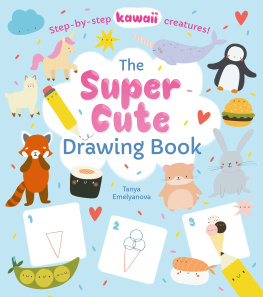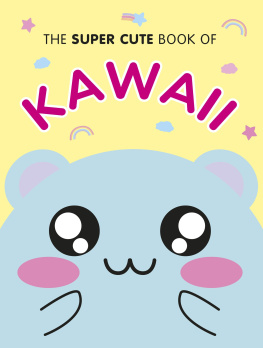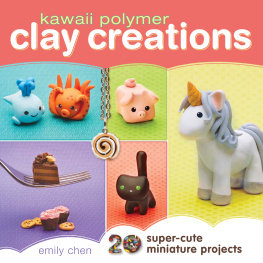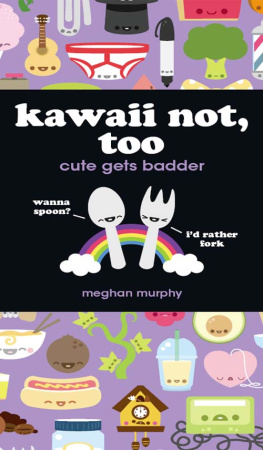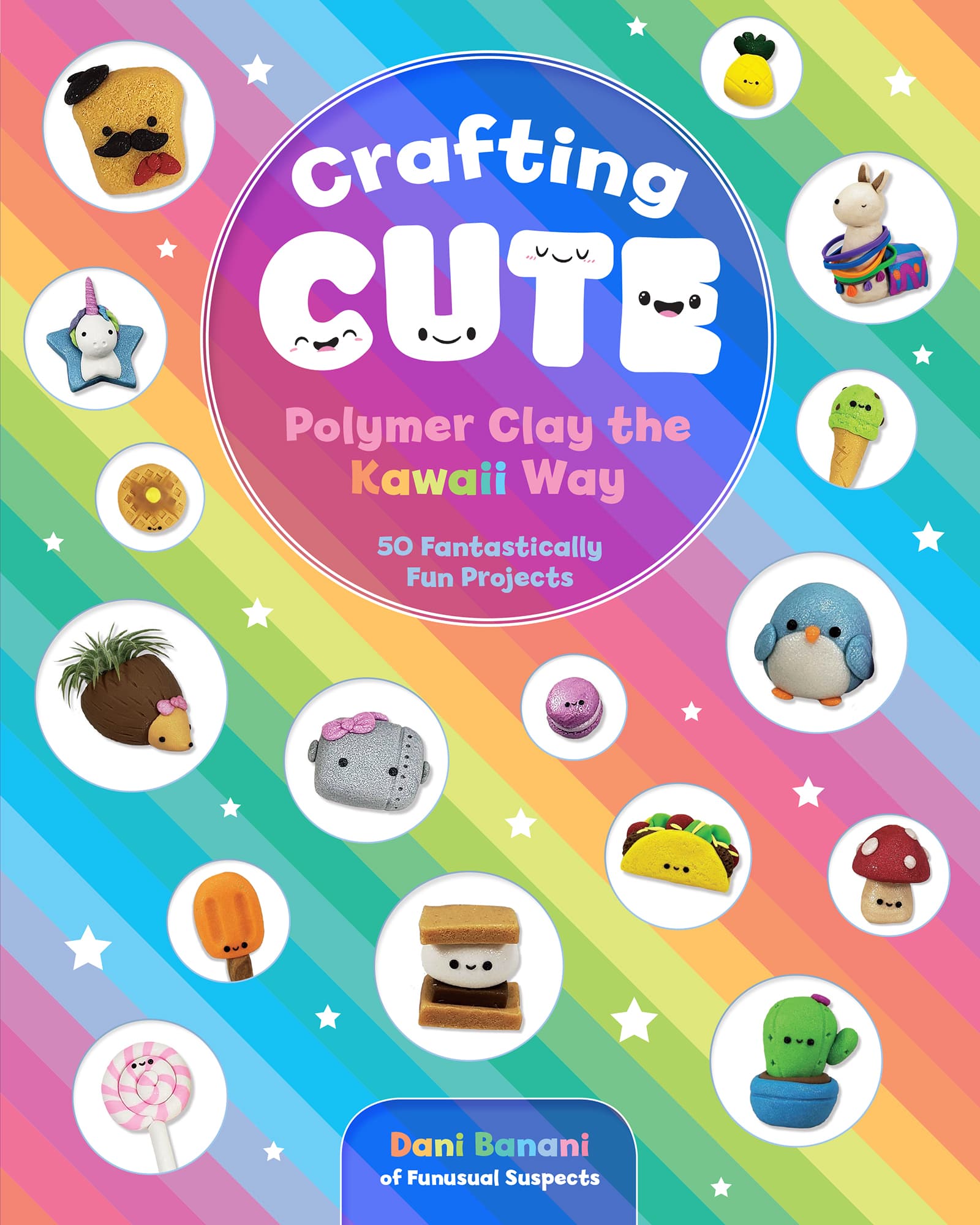Hi! Im Dani, the artist and crafter behind the polymer-clay projects youre about to dive into. My friends call me Banani, and since I hope well be friends by the end of this book, you should call me that too.
Actually, anyone who is interested in art, crafting, and handmade hobbies, is a friend of mine. I grew up in Nebraska, but Ive lived and worked in and around Seattle for more than a decade. Ive always doodled, sketched, and drawn ever since I was a little girl, and it was always my dream to be able to make art when I grew up. Well, after moving west, and taking a series of retail jobs, I finally managed to break into commercial digital graphics work, which was fun, helping me to refine my style and speed up my process. But, as much as I enjoyed that, I still longed to work on my own art, my own concepts.
HOW I BECAME A POLYMER-CLAY ARTIST
I kept drawing and sketching, and then in the spring of 2015, I saw some polymer clay in a craft store. I had no idea how to work with it or what I could do, but I decided to give it a try. After a few hours of playing and experimenting, I was hooked! It was everything I wanted in a hobby: its creative, quick and easy to learn, results oriented, inexpensive, and adaptable to virtually any style. So, I started making cute, little charms based on some of my doodles and characters. And in a few weeks later, I was getting requests for custom pieces! (OK it was my mom, but still!)
I experimented with different styles and techniques, some that I made up myself and some I found via online videos or short tutorials about various aspects of polymer-clay crafting. Months of trial and error followed, as I learned what works, and what doesnt. After some encouragement from friends and family, I decided to offer my items for sale online through an Etsy shop. For the first few months, I had some polite interest in a few of my pieces. Then, in early 2016, I made a small sloth air plant holder that people really liked. He was cute and cuddly and hugging a tiny plant in his arms (the air plant was a Tillandsia, which doesnt require soil). It struck a chord with people, and suddenly I was getting requests for all kinds of cute critters, done in my particular kawaii style (shown to learn more about this).
My husband, Trevor, and I are always making silly puns and jokes, so those have become a key feature of many of my designs, including visual puns in my clay projects. Fast forward a few years, and now managing my online shop, FunusualSuspects.com, and making cute clay objects have become my full-time job. In fact, our little operation has even expanded to include a CEO (Cat Executive Officer named Morrie) and a Head of Security (our dog, Absa)!
HOW TO USE THIS BOOK
The projects in this book are designed around all the things that I love about polymer-clay crafting: they are easy and inexpensive to make, along with being cute and colorful! I created simple, quick, and small projects to get you started, and then building upon that solid foundation, I show you how to make more complex designs. I hope there is something in here for everyone, at every skill and experience level, but these projects are especially geared toward those looking for a quick and easy entry point into the world of polymer-clay crafting. With a very small investment in time, tools, and materials, you should be able to create something unique, cute, and useful, which youll be proud to give to friends or show off on your desk.
The projects are broken down into three categories: twenty-five small projects (20 to 30 minutes) shown . The techniques and skills you learn in the early projects will be very helpful in the later ones, but you dont necessarily have to go through this book in any order. Feel free to find a project that really speaks to you and makes you excited (and maybe even a little scared) to try it. Go for it! Youve got this, and Ill be right here to help. You can always refer to an earlier project if you need to pick up a skill to finish a more complex one. Take your time, be patient, and remember: practice makes perfect. If you arent happy with the result, you can always smush the clay all up and start over again as long as you havent baked it yet.
Thanks for coming along with me on this cute and crafty adventure in Crafting Cute. I have kept things fun, fresh, and fast, because I know your time is precious and I want to make the most of it. If you get stuck or have questions, reach out on Facebook, Twitter, or Instagram (@funusualsuspects), and Ill do my best to help. And make sure you share your creations with me! Id love to see photos of all your projects.
OK, are you ready to have some fun and make some cute stuff?! Then lets get started!
What Is Kawaii?
Kawaii, which means cute in Japanese, is an illustration style first made popular in Japan but has since gained a worldwide following. Its everywhere now, so you probably have seen this style of anthropomorphizing everyday objects by putting cute, expressive faces on them, along with the adorable chibi style of character design that transforms animals and people into ultra-cute childlike figures.
I was drawn to this style of art (pun intended) because of the way its used to create an instant emotional response in the viewer. People automatically have an awww! moment when they see this kind of cuteness, and I wanted that kind of reaction to my work. My goal is to bring a little more joy into the world, and kawaii is a simple, elegant way to do that.
Making kawaii art might seem easy and simple, but it does take some thought and planning in the case of polymer-clay crafting. Cuteness is subjective, so what might seem adorable to one person may fall flat with another. You have to find the right balance between being delicate and subtle and bold and broad. The creation of the face with black clay in most of the designs gives you a lot of room to make them unique to you. You can play around with the spacing, the size, the placement, the angleall of it can make a difference in the overall effect. And remember, after its baked, its a finished piece, so take the time you need to get it right before it goes into the oven.
The other reason I chose the kawaii style for this book is that its a great way to start in polymer clay. Other styles might be more intricate, or require extra steps, like painting, but if you can make these projects, with just the simplest lines and curves, and make it cute, I think that gives you a great foundation on which to build whatever styles you may want to eventually branch out into.
Materials and Tools
You dont need to have all these materials and tools on hand before you get started crafting with polymer clay. Start with just a few simple projects, and then grow your clay variety and toolset as you progress through the book. Go at your own pace, have fun, and experiment! Find out what materials and tools work best for you. There are no hard-and-fast rules here.




